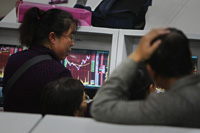
The global financial crisis has Chinese leaders and citizens worried as the ripple effect(连锁反应) from U.S. markets has exacerbated(使恶化) already slumping(暴跌) Chinese markets.
Worldwide demand for the Chinese exports has already decreased, leading to a stall in domestic industrial production. Factory closures(停业) and layoffs in southern China have also led to protests as the unemployment rate climbs.
On November 10, 2008, China announced a historic $586 billion stimulus(刺激) package aimed at encouraging growth and domestic consumption in ten areas of Chinese society ranging from infrastructure(基础设施) investment to environmental protection and disaster rebuilding.
The package would aid cement(水泥), iron and steel producers through its investment in infrastructure and encourage growth by removing loan quotas(贷款额限) on lenders and increasing credit for major projects that help rural areas and small businesses, the government announced.
Prior to this China had also instituted cuts in interest rates, set aside funds for infrastructure construction, and instituted measures to boost(推动) real estate(房地产) sales. It has also announced greater rebates(可减免的款额) on taxes charged to exporters.
Effect of the Crisis on China
In many ways, China is currently less affected by the financial crisis than other countries, due to its more closed financial system. This has led other nations to urge China to lend a greater financial hand such as increasing its own imports.
But any slowdown in China's growth can have significant effects. Some economists, such as Nouriel Roubini, have cautioned that China could face a recession if it's growth rate were to slow to even as high as 6 percent. Roubini argues that China needs to maintain at least a 9 percent growth rate just to handle it's growing labor force and move farmers to the urban sector. China may be in for a hard landing, Roubini writes.
China's growth rate for the third quarter of 2008 was 9 percent, the slowest rate that China has seen in five years.
For months, China has also seen consecutive(连续的) drops in housing prices. Other industrial sectors such as electricity production, textiles, non-ferrous materials(有色金属材料) and information technology have also seen heavy losses.
Current Chinese Policy to Stem the Crisis
According to a statement on the Chinese government's Web Site, the latest financial stimulus package covers ten areas including: housing, rural infrastructure, transportation, health and education, environment, industry, disaster rebuilding, incomes, taxes, finance.
The measures will loosen credit restrictions, cut taxes and begin massive infrastructure spending.
The cabinet, known in China as the State Council, had gathered in an executive meeting in early November, headed by Chinese Premier Wen Jiabao to address China's response to the global financial crisis. After the two-year package was announced on Nov. 10, the cabinet issued the following statement:
"As long as we take the right measures in a resolute and timely way to grasp the chance and rise to the challenges, we will surely secure steady and relative fast economic growth."
Some critics have said that the stimulus package is unclear, as some of the funding plans had already been announced in the works.
China has previously enacted(制定) a series of new measures to boost the domestic real estate market by exempting(免除) taxes on properties and land. In late October, China also cut interest rates - the second time it did so that month.
Leaders have also pushed for increased industrial restructuring and greater support to export-oriented companies and farmers.
Lessons from the 1997 Asian Financial Crisis
China had a similar, though much smaller package passed during the 1997 Asian financial Crisis, where it spent large sums to build up its domestic road system to keep the economy growing.
China was able to remain relatively unscathed(未受伤的) from the 1997 crisis while many of its neighbors fell into a recession. Because Chinese investments didn't center on securities, the country was also relatively insulated(绝缘的).
The crisis also forced China to look at fixing the many of its financial weaknesses such as its many non-performing loans, it's antiquated(过时的) banking system, and its reliance on U.S. trade.
During the crisis, China also chose not to devalue(使贬值) its currency(货币), allowing for an anchor(锚) of stability, which aided the recovery of its neighbors. The Chinese currency had a fixed exchange rate that was tied to the U.S. dollar for many years.
In 2005, the peg was lifted and the yuan was now subject to a managed floating(管理浮动汇率制的) exchange rate based on supply and demand, within certain limits. Some nations have argued that it has not been devalued enough.

